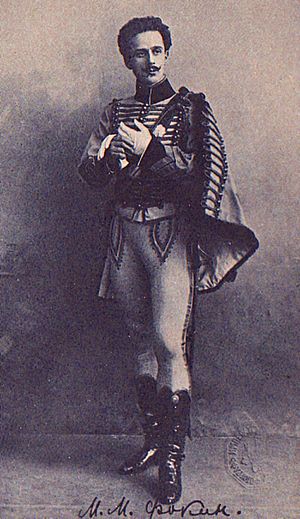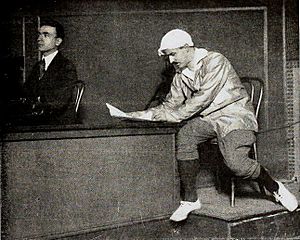Michel Fokine facts for kids
Quick facts for kids
Michael Fokine
|
|
|---|---|
| Михаил Фокин | |

Fokine in Arlequin, 1914
|
|
| Born |
Mikhail Mikhaylovich Fokin
23 April 1880 |
| Died | 22 August 1942 (aged 62) |
| Nationality | Russian, naturalized U.S. |
| Occupation | Ballet dancer, choreographer |
| Spouse(s) | Vera Fokina |
Michael Fokine (born April 23, 1880 – died August 22, 1942) was a very important Russian choreographer and dancer. He changed the world of ballet with his new ideas.
Contents
Fokine's Ballet Career
Early Life and Dancing
Michael Fokine was born in Saint Petersburg, Russia. His family was quite wealthy. When he was nine years old, he was accepted into the famous Imperial Ballet School.
In the same year, he performed for the first time in a ballet called The Talisman. In 1898, when he turned 18, he made his official debut at the Imperial Mariinsky Theatre in the ballet Paquita.
Besides being a talented dancer, Fokine also loved painting and was good at it. He could also play musical instruments like the mandolin, domra, and balalaika.
Becoming a Choreographer
Fokine started to feel that being just a dancer was not enough for him. He wanted to explore more artistic ideas. In 1902, he got a job teaching at the Imperial Ballet School. This gave him a chance to try out his ideas for choreography, which is the art of creating dances.
In 1905, he created his first full ballet, Acis et Galatée. His students performed it. One of his early works was The Dying Swan (1907). This was a solo dance created for the famous ballerina Anna Pavlova. It was set to the music of Le Cygne.
Fokine also worked with a young dancer named Vaslav Nijinsky. He featured Nijinsky in ballets like Chopiniana (1907), which was later renamed Les Sylphides in 1909.
Working with Ballets Russes
In 1909, a very important person named Sergei Diaghilev invited Fokine to join his new ballet company, the Ballets Russes, in Paris. Fokine became their main choreographer.
At Ballets Russes, Fokine worked with other artists to create amazing ballets. One famous ballet was Scheherazade, which premiered in 1910. It was inspired by the tales of the 1001 Nights. The colorful sets matched the dances perfectly. Nijinsky played the Golden Slave in this ballet.
Another famous ballet was The Firebird (1910), with music by Igor Stravinsky. They created this ballet together, mixing music, story, and dance into one complete artwork.
Petrushka (1912) also had music by Stravinsky. It was inspired by a Russian puppet character. Fokine included many characters like street dancers, peddlers, and a performing bear to make the story come alive. The ballet was about a magician and his three puppets: Petrouchka (Nijinsky), the Ballerina, and the Moor.
In 1911, Fokine created Le Spectre de la Rose. In this ballet, Nijinsky played the spirit of a rose. His exit was famous: he jumped out of a window, making it look like he was flying in the air.
Fokine left Ballets Russes in 1912 but returned in 1914. During this time, he created more ballets like Midas and Le Coq d'Or.
Moving to America
When World War I started in 1914, Fokine returned to Russia. Later, in 1918, he moved to Sweden and then to New York City. In New York, he opened a ballet school in 1921. He also continued to perform with his wife, Vera Fokina.
By 1924, he started his own group called the American Ballet Company. They performed often at the Metropolitan Opera House and toured around the United States.
His ballet Les Sylphides was the first show performed by the American Ballet Theatre in 1940. Fokine continued to create new works until 1941. He created more than eighty ballets in Europe and the United States. His most famous works include Chopiniana, Le Carnaval, and Le Pavillon d'Armide. Many of his ballets are still performed around the world today.
His Passing
Michael Fokine died in New York on August 22, 1942, when he was 62 years old. To honor him, seventeen ballet companies around the world performed Les Sylphides at the same time.
Fokine's New Ideas in Dance
Fokine wanted to change ballet from just showing off difficult steps to telling a story and showing real feelings. He believed that dance movements should express emotions and ideas, not just be fancy tricks. He thought that if movements didn't express something, they weren't interesting.
He also wanted to get rid of old-fashioned costumes and techniques that didn't fit the ballet's story. Fokine studied Greek and Egyptian art to find new ways to move.
He even suggested that dancers should not always wear pointe shoes. He believed pointe should only be used when the dance needed to show a soaring or upward feeling. He wanted dancers to perform barefoot in his 1907 ballet Eunice, but the theater said no. So, he had toes painted on the dancers' tights to make them look barefoot!
Fokine also experimented with using the whole body in dance, not just the legs. He encouraged dancers to use their arms and torsos more freely. He wanted every muscle to move with a clear purpose. By doing this, Fokine brought new life to ballet as an art form that could truly express feelings and stories.
In 1923, he created the ballet Ajanta Frescoes for Anna Pavlova. This was after she visited the famous Ajanta Caves in India.
Cultural Depictions
- Nijinsky (film), a film by Herbert Ross - Fokine was played by Jeremy Irons (1980)
- Anna Pavlova, a film by Emil Loteanu - Fokine was played by Sergey Shakurov (1983)
See also
- List of dancers
- List of Russian ballet dancers
- In Spanish: Michel Fokine para niños



